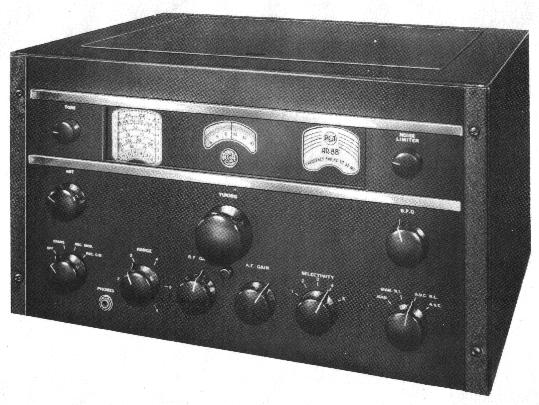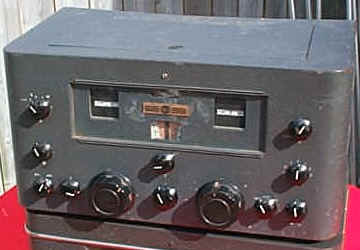
http://www.w9wze.org/Equipment/Photos/ZOther/rca_ar-77.jpg
540 kHz to 33 MHz (over 6 bands), AM, Receiver; 110VAC (115/220 for AR-77E)
[ http://www.kc2kj.net/rca/ar77.html ]
The AR-77 was a communications and general purpose receiver for the consumer and amateur radio market. A matching MI-8413 "extended range high fidelity loudspeaker" was available (the AR-77 sat on top of the large floor-mount speaker). It had 10 tubes. The AR-77E was the "export" model and could be operated over a supply voltage range of 105 to 250 VAC.
Manual/schematics available at http://www.nostalgiaair.org/PagesByModel/414/M0015414.pdf
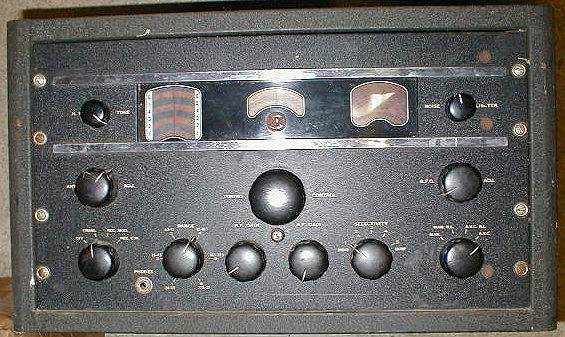
http://www.mississippi.net/~comcents/radios/rcaar88.jpg
525 kHz to 32 MHz (AR-88D), AM, R/T and CW. Powered by AC mains or separate 6V DC.
[ http://www.wftw.nl/receivers/receivers.html ]
The AR88 is a general purpose communications receiver manufactured by RCA in the USA between 1941 and 1945. They were made in large numbers for service use. Most were sent to the UK and Russia for the war effort. They came in 2 versions, the AR-88D and the AR-88LF (low frequency version). The RAF designation was R1556A, and R1556B for the LF version.
[ http://www.armyradio.co.uk/publish/Articles/AR-88_Receiver/AR-88LF_Receiver.htm ]
[ http://www.jvgavila.com/ar88.htm ]
Articles & Manuals (PDF format)
(courtesy Rich McClung, WA6KNW)
- AR88 Instruction Manual – IB–25927–2 (3.0 MB)
- AR88-LF Instruction Manual – 113995-1 (1.4 MB)
- CR-91 Instruction Manual with July '44 Addenda – IB-25974-1 (8.1 MB)
-
Getting the Most From Your AR–88
– by D.M. Gill, 4S7MG (3.9 MB)
The Short Wave Magazine, August 1958
-
Getting the Utmost From Your AR–88
– by W.K. Miller, G6QF (2.5 MB)
The Short Wave Magazine, April 1953
- AR–88 / CR–88 Pictures (3.4 MB)
- The AR88 Again – by Tom Bloxham, GW3LJS, October 2001 (0.3 MB)
- RCA DB Tuning Meter Kit (MI–17210) for AR–88D, CR–91 (1.2 MB)

http://www.armyradio.co.uk/publish/Articles/AR-88_Receiver/Pictures/ar88_01.jpg
This is the LF receiver, and it is very nice to use, with the exception of the small dial scale and band indication. The tuning is smooth and it is very sensitive. It is also very stable. The front panel layout is handsome, with dial light behind the 3 windows.
The circuit uses 2 RF stages (6SG7), a first detector (6SA7) and oscillator (6J5), 3 IF stages (6SG7), second detector and AVC (6H6), noise limiter (6H6), BFO (6J5), AF amplifier (6SJ7) and power output amplifier (6V6GT), a power supply (5Y3GT), and regulator (VR150). They are all metal valves except for the audio output, rectifier, and regulator. The aerial can be a 200 ohm balanced line or an unbalanced single lead in, connected to screw terminals on the back.
The main differences between the AR88D and the AR88LF are the frequency coverage. They also have different IF frequencies (AR88D is 455kcs, AR88LF is 735kcs) and different audio output valves (AR88D is 6K6, AR88LF is 6V6).
It is a 19" rack mount type chassis, and usually comes in a cabinet, the total weighing 100 pounds. It will run on 115v or 240v AC mains, 25-60 cycles and draws 100 watts. It can also run on 6v DC (12 amps) with the external power supply type MI-22215 (a vibrator supply). It can also have an external metal speaker box. The sensitivity is quoted as 15 micro volts for 20db signal to noise for MCW and 5 micro volts for CW. It will deliver 2.5 watts to the loudspeaker. The designers have put a lot of effort into screening the RF and oscillator circuits to reduce radiation, and making the receiver stable by rugged metal work, temperature compensated oscillator circuits, and a regulated HT supply for the oscillator.
[ http://www.armyradio.co.uk/publish/Articles/AR-88_Receiver/AR-88LF_Receiver.htm ]
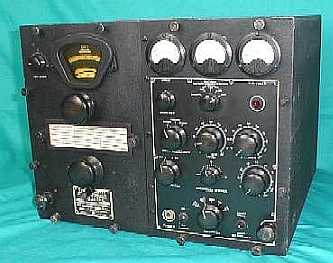
http://radioblvd.com/hampix/rbb2.jpg
Designed by RCA for ultimate reliability and performance, the RBB-2 was one part of a larger group of receiving gear used by the Navy. Using 19 tubes with separate power supply, the frequency range covered by each model is somewhat limited, though with a full compliment of RBA, RBB & RBC models, one had coverage from Longwave up to 27mc. The RBB covers 500kc to 4.0mc and features double preselection on all bands, meters galore, super smooth tuning with accurate dial readout and a squelch control.
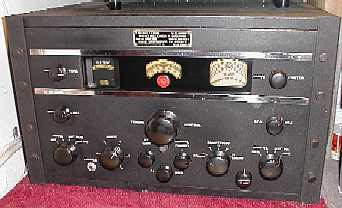
http://radioblvd.com/hampix/sc88.jpg
RCA's great receiver creation was the AR-88. Designed in 1941, it was a 14 tube superheterodyne with incredible sensitivity (even up to 10 meters), good stability and decent audio (single 6K6.) Much of the production ended up in England or Russia because of WWII. The receiver pictured is actually the last of the '88 versions, the SC-88, (Signal Corps designation R-320/FRC, SN 214), from 1950, which has "band-in-use" masking and the crystal phasing control on the front panel (the AR-88's is internally adjusted.) The AR-88 series' three IF stages are stagger-tuned (with two under-coupled transformers and two over-coupled transformers) requiring a sweep generator and oscilloscope for proper alignment. Many of the AR-88 variations were used in triple diversity receivers like the DR-89 - a seven foot tall rack loaded with three AR-88s and auxiliary equipment. The diversity receivers did not have S-meters installed because the S-meters for all three receivers were actually installed outboard on the Meter Panel of the DR-89 rack.
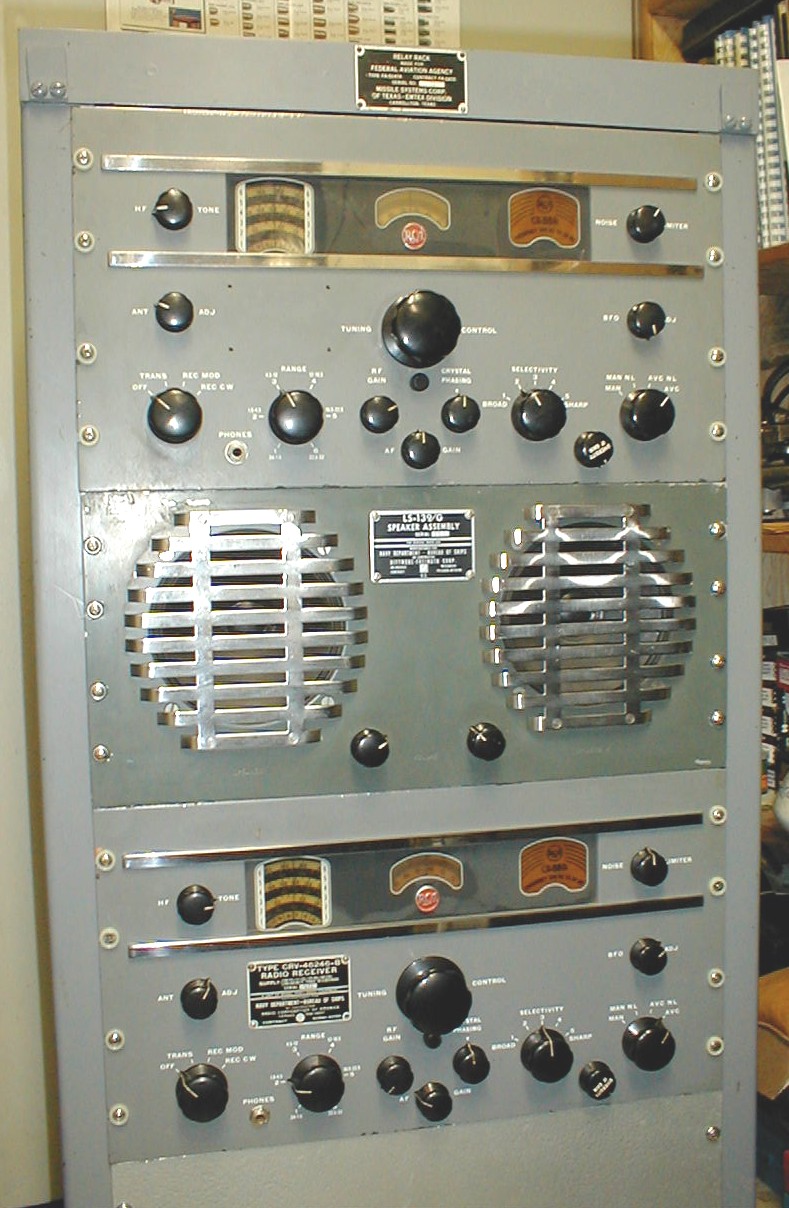
http://www.hal-pc.org/~tsmith/CR88A.jpg
Dual diversity receiver rack with two CR-88A receivers, both with the diversity control. The Navy tag on one of them that says "TYPE CRV-46246-B," with the tag missing from the other. These receivers are mounted with a Navy LS-139/G speaker assembly unit (two speakers with controls).
AR-88 and CR-88A receiver covers 535 KC to 32 MC in 6-Band, 115 VAC
AR-88A/CRV-46246 used on REK, CRV-46246A used in RDM, CRV-46246B used in RDM-1
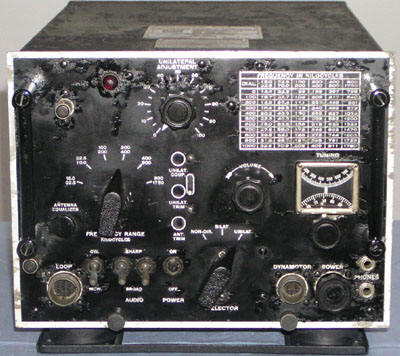
http://www.vk2bv.org/museum/dz-2.htm
Naval Aircraft LF direction-finding receiver, 15-1750 KC in 6 bands (15-32.5, 32.5-70, 100-200, 200-400, 400-800, 800-1750; 28VDC using external dynamotor; loop antenna with sense; tubes: 3x 6D6, 2x 6C6, 2x 76, 1x 41; Weight 37.6 lbs; Contract No. 67427 (30 June 1939) - RCA Camden, NJ
[web:
http://www.vk2bv.org/museum/dz-2.htm
Schematic:
http://www.vk2bv.org/museum/dz-2-cct.gif
http://www.radiomilitari.com/dz2.html ]
